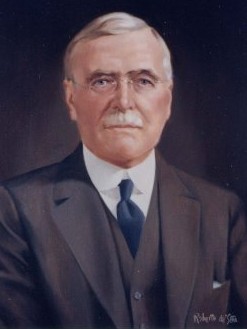Mon 27 Feb 2006
‘The Most Remarkable Sheep Story Ever Told’
Posted by Jim under History, John Miller/Thistle Ha', Lore, Robert Miller/Burn BraeComments Off on ‘The Most Remarkable Sheep Story Ever Told’
Robert Miller’s portrait (pictured) hangs in the Canadian Agricultural Hall of Fame Gallery located at the Royal Agriculture Winter Fair in Toronto.
 At age 20, Robert became the eldest of John Miller’s sons living at Thistle Ha’. Over the next two decades, he became the leader of the John Miller & Sons livestock business, firmly establishing the reputation of Thistle Ha’ as a great centre of purebred livestock activity. Starting in 1881 on behalf of Thistle Ha’ and later for his Burn Brae farm at Ringwood, Ontario (Stouffville), Robert Miller made over two dozen trips to Britain and north-western Europe, importing livestock for improvement of breeding herds in Canada. During his travels, he developed an extensive sales network, and gained markets for Ontario breeders in the United States and Mexico. By visiting all the top livestock farms, he saw world breeding trends, and developed an ability of nearly always selecting the best livestock for his customers. Because of this reputation, he was widely sought after as a judge at livestock shows.
At age 20, Robert became the eldest of John Miller’s sons living at Thistle Ha’. Over the next two decades, he became the leader of the John Miller & Sons livestock business, firmly establishing the reputation of Thistle Ha’ as a great centre of purebred livestock activity. Starting in 1881 on behalf of Thistle Ha’ and later for his Burn Brae farm at Ringwood, Ontario (Stouffville), Robert Miller made over two dozen trips to Britain and north-western Europe, importing livestock for improvement of breeding herds in Canada. During his travels, he developed an extensive sales network, and gained markets for Ontario breeders in the United States and Mexico. By visiting all the top livestock farms, he saw world breeding trends, and developed an ability of nearly always selecting the best livestock for his customers. Because of this reputation, he was widely sought after as a judge at livestock shows.
When the directors of the Chicago International, the pre-eminent livestock show in North America, were asked by their counterparts in Argentina to send judges to their Palermo (suburb of Buenos Aires) show, which was then the biggest livestock show in the world, Robert Miller went as one of the judges.
As a July 28, 1923 a newspaper article [writer and newspaper unknown] notes, Robert Miller was in for a shock when he started judging the sheep:
The Palermo show authorities asked the directors of the Chicago International to send three judges for the 1916 exhibition. One of them was to judge draught horses and sheep, an unusual combination, of which Robert Miller of Stouffville was judged to be the most notable possessor. So he went down south on a trip that took in Brazil and Chili [sic] (on the return), and showed what a Latin display, mainly of animals deriving from the British Isles, could be and do.
In one class of Lincoln rams two hundred and ten animals had to be judged: seventy pens of three each. Mr. Miller at first was almost flummoxed by the formidability of this task, especially as a champion had to be named from the array. Looking over the lot, four pens obviously stood out from the rest, and he had no difficulty in awarding the first four prizes, the choices between them being hard enough to make.
When the day was over, a great breeder of that country, an Englishman, asked Mr. Miller if he would like to know to whom the first four prizes went. They were won by brothers named Gibson, each of whom took two prizes. The Gibsons, it was explained, were Englishmen who had come to Argentina from Tasmania, bringing their flocks with them, and settling on the coast, where the salted air had developed a wonderfully fine texture of wool on the Lincolns, perhaps the most famous breed for fineness and luster of its fleeces. Twenty years before Mr. Miller had been asked by Mr. Mansell, one the leading English sheep authorities, to help him select the foundation of the Lincoln flock, which two Gibson brothers were taking to Tasmania. The four pens to which Mr. Miller gave the prizes in Palermo, knowing nothing of their ownership or origin, were descendants of the rams and ewes he had selected for the Gibsons.
